Part 4 - Animals Migrating Overland
Migrating elephants, the largest living land animals, weigh between two to seven tons. One of the smallest migrating land animals, the Belding's ground squirrel weighing only 125 grams (4 ounces), starts migrating at the age of only two months. Some of these species, varying so greatly in size, migrate to find feeding grounds or more suitable environments, while others migrate for reasons not entirely understood.
Elephants
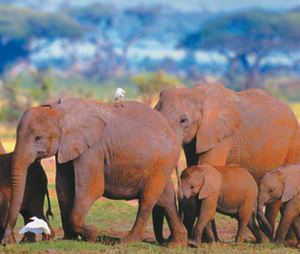 The daily feeding requirements of a mature elephant are very high. An elephant consumes around 75 to 150 kg (165 to 330 pounds) of food and 150 to 300 liters (40 to 80 gallons) of water a day, which is why an elephant community, roaming as a herd, needs a number of feeding grounds. Elephants journey constantly over hundreds of kilometers to feed on leaves, tree bark, fruit, grass and plants.
The daily feeding requirements of a mature elephant are very high. An elephant consumes around 75 to 150 kg (165 to 330 pounds) of food and 150 to 300 liters (40 to 80 gallons) of water a day, which is why an elephant community, roaming as a herd, needs a number of feeding grounds. Elephants journey constantly over hundreds of kilometers to feed on leaves, tree bark, fruit, grass and plants.
They spend 70 to 90% of each 24-hour day either feeding or moving towards new sources of food. The remainder of their time is spent bathing, drinking, resting and sleeping. Usually they'll spend up to a few days in one place before moving on, since if they do not, they may totally exhaust the vegetation in that area.
Nowadays, elephants live principally in East Africa and in the Far East, especially in Sri Lanka. Their migration to new feeding grounds occurs mainly when there is no rainfall. For this reason, elephant herds are more common in the dry season. Rainy season is best suited for calving, so mating and birth take place in the rainy season. The gestation period in elephants lasts 22 months, the longest in all land mammals, so that the same weather conditions prevail when they become impregnated as when they give birth, so that calves are born when food is abundant.50 This perfect timing in giving birth is remarkable. Migration of elephants to find food in areas of high rainfall is still a mystery, in spite of research into how these animals determine which direction to travel in, and what factors they use to determine the right time to migrate.
Only a number of theories have been put forward. So far, research suggests that elephants make use of the Sun, Moon, and stars, landmarks such as mountains and rivers, as well as the length of daylight hours and climatic changes like heat, wind, and humidity. Nevertheless, no organ or system in their bodies has yet been discovered that would allow them to do so. It is thought that the elephants' keen sense of smell and their skin's extreme sensitivity to detect wind direction play a role in their migratory movements.
All these suppositions and deductions have one thing in common: These animals must have an accumulation of knowledge to determine direction by the position of heavenly bodies. Professional route-finders need years of training in mathematics and physics, yet these creatures need no maps, chronometers, compasses, or charts to find their way with certainty.
This is enough to prove that they have been created by a supreme Creator Who equipped them with whatever they require. This Creator is God, Lord of the Earth and the heavens and all that lies between. God's power is infinite and incomparable. Humanity's most important responsibility is to live as He desires, understanding this truth and praising Him:
O humanity! Worship your Lord, Who created you and those before you, so that hopefully you will guard against evil. It is He Who made the Earth a couch for you, and the sky a dome. He sends down water from the sky and by it brings forth fruits for your provision. Do not, then, knowingly make others equal to God. (Surat al-Baqara, 21-22)
Caribou Migrations
 |  |
| Throughout the ages, man has invented a number of navigational instruments. However, shortly after migrating animals come into the world, they can find their way to places thousands of kilometers away with no assistance. Their perfect bodies and the skills they possess are doubtless the work of God, our Creator. |
The barren-ground caribou (Rangifer tarandus) is one of the longest distance travelers of animals migrating overland. They generally inhabit regions where winter is severe, but these animals are strong walkers. Satellite tracking of ten adult female caribou established that they traveled 4,350 kilometers (2,700 miles) from their forest winter habitat to the coastal plains. One cow from this herd set the world's record for the longest journey by land mammals at 5,055 kilometers (3,140 miles) in a year.51
The reason for caribous' migration varies according to the season. In spring they travel from their winter habitat to where they will give birth to their young. Pregnant females start their journey while the ground is still frozen, and the calving grounds are also snow-covered when they arrive. But they must find food when their young are born, and they give birth in places where there is an abundance of flower buds of cottongrass and other vegetation. They stay in the region for 7 to 10 days to feed.
It's not yet known exactly what environmental signs influence the start of migration, but a group of pregnant females was observed to adjust their rate of migration. This group of cows was delayed on account of the depth of the snow. But once migration began, they traveled more than 40 kilometers (25 miles) a day, arriving where they were to give birth at the same time as another group of cows that had set off a month before them, having covered a distance of only 6 kilometers (3 1/2 miles) a day. This is an astounding indication of consciousness. Whatever the conditions, God has inspired these animals to be where they should be, at the time they should be. Otherwise, it wouldn't be possible for an animal to calculate the distance to the place where it will give birth, how many days remain until that time, and how far it should travel every day to get there on time. A caribou does not have such powers of judgment.
For the time of the migration, the caribou waits until the conditions are the most favorable—when the ridges are exposed to strong winds, when the lakes are frozen over, and the snow is either shallow or crusted. The deeper the snow, the more energy they will have to use. When forced to walk in deep snow, they march in single file, and an adult female usually takes the lead. She opens a path in the snow so the others use less energy following her. After a few hundred meters, another caribou takes over the lead.52 This is clever organization, and it can't be said that caribou do this of their own free will, displaying self-sacrificing behavior by conscious agreement among themselves. It is not possible for an animal to develop such a method and have the others agree. But since these animals act in this way from the first moment of their existence, they must have been taught this behavior. And no doubt, the One Who has taught all caribou from their very first moment in time is their Creator, our Lord God.
Deer that Assess the Nutritional Value of Plants
As already stated, caribou are constantly on the move; and what drives them to this activity is the search for food. The basic forage is lichen, which is an easily digestible, but slow-growing plant. The deer usually winter where there is an abundant supply of lichen but little snow, making it easier to reach the food supply. In summer, they need protein and minerals to produce milk in order to suckle the newborn fawns. And lichens contain very little of these. The nutrients in plants vary according to latitude, altitude and soil composition. At high latitudes, plants are rich in protein and minerals as well as being easy to digest—but only at the beginning of the growth season, not in all seasons. As if they were aware of this fact, caribou move to such areas at the beginning of summer.
 |
Further into the summer season, the nutrient value of these plants is gradually reduced. As temperatures drop and snow starts to cover the ground, lichen once again becomes the most suitable food, and for this reason, caribou start migrating back to their winter grounds. It is not possible for these animals to think like botanists or geography experts and know which plants grow at what season at what latitude, what nourishment these plants contain, and what direction they need to go in to reach them. But these animals consistently display exactly the right behavior they need to continue their existence, which clearly shows that this behavior has been taught to them.
With endless mercy, Almighty God protects the life forms He has created. In addition to creating the deer's bodies to be totally compatible with the conditions under which they exist, God inspires their behavior at all times. These creatures live their lives with the inspiration of God, and each one of them is evidence of His infinite power:
The Originator of the heavens and Earth. When He decides on something, He just says to it, "Be!" and it is. (Surat al-Baqara, 117)
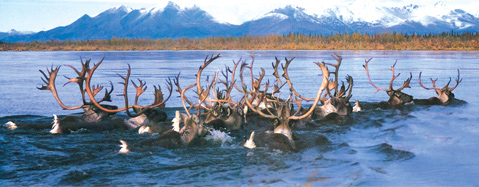 |
Wildebeest
For the wildebeest, life is a constant search for food and water, and for this reason they migrate. Wildebeest travel north from the Ngorongoro Crater Highlands in the east to the shores of Lake Victoria in the west as far as the Mara country in Kenya. This area of 30,000 square kilometers (11,600 square miles) is known as the Serengeti-Mara ecosystem. Their annual migrations in this vast area cover 3,000 kilometers (1,900 miles).
The wildebeest take routes similar to those they have taken before, but every year their movements vary slightly. How long it rains and at what time of the year has an effect on food availability and hence, on the animals' migration. At the start of the rainy season in November or December, the wildebeest move from the dry regions of the acacia woodlands in the north and west of the ecosystem to the treeless grassy plains of the Serengeti. The wildebeest herds form a great mass that grazes as it advances. Even though each animal is on the move at all times, the herd covers a certain area for a week or so. They do not stay in one place for long, because there is not enough grass in their range to support such a great number of animals.
Crossing the Mara River
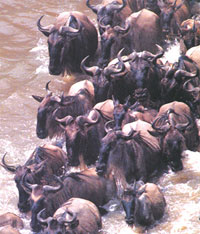 | Left: Towards May, plains in the Serengeti dry out, the grass withers, and the wildebeest start migrating north to the plains where long grass is more plentiful. Some years, more than a million wildebeest cross the Mara River to reach the Masai Mara reserve in Kenya on the other side | 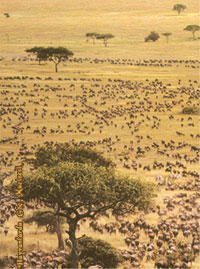 |
| Right: When rains come to the Serengeti and the short grass grows green, the wildebeest start migrating back. When the rainy season ends in May, the dry season begins again. As the plains lose their green grass, the wildebeest are forced to start a new migration north |
In some years, more than a million wildebeest cross over Kenya's Masai Mara reserve. In spite of the dry season, there is extensive grazing land in the area known as the Mara and Lamai Wedge in the northwest of the Serengeti. But to reach these rich pastures, the wildebeest have to cross the Mara River. In July or at the beginning of August, thousands of wildebeest pour down from the northern Serengeti in order to cross the river. Sometimes they choose highly dangerous points and fall off cliffs or struggle to get through seemingly impossible mud flats. Some drown. Older, more experienced ones use places where they have crossed before, and the young follow them.
Whatever incites the animals to make this crossing—sometimes, purely because they want to drink water—once they have started, nothing can stop them. If motor vehicles or predators try to block their way, they cross at a different point, and have been known to reach the river through the forest.
Towards the end of September or October, wildebeest in the Mara region start returning to the Serengeti. The rains have started, and the herds move further south, following the rain. If the rain stops, they wait at the edge of the woodlands, and continue their migration when it starts raining again. In December they reach the plains of short grass.
The volcanic soils of the Serengeti are rich in nutrients, but just below the surface lies a hard layer of calcium carbonate. This hard layer does not admit trees' roots, but supports growth of perennial grasses. In the cold nights, these grasses' short roots absorb every drop of condensation. This enables them to survive even the driest days, and after the rain, they start sprouting.
These Serengeti grasses consumed by the wildebeest have short stems with small leaves, a response to protect them from thousands of hungry animals. Being constantly grazed keeps the grasses short. Moreover, during grazing, the plants' growth hormones pass from the roots into new shoots, thus aiding new growth. The animals' saliva also has an important function as a growth stimulant.53 Wildebeest do not stay long enough in the same environment to cause damage, and they also enrich the soil with their manure as they move from place to place.
God creates everything perfectly and provides for all. The harmony in the habits of the wildebeest and the special composition of the soils where they live, the special characteristics of the grass that grows there, and many other details all demonstrate that every phase of the migration phenomenon has been created.
Truly God, He is the Provider, the Possessor of Strength, the Sure. (Surat adh-Dhariyat, 58)
Migration of Ground Squirrels
Most ground squirrels live in groups on open grassland, eating grasses and seeds. At night they sleep in underground nests. The distances these little creatures migrate are very great in relation to their body size. At the age of only two months, when they are half the size of the adults and weigh only 125 grams (4.5 ounces), Belding's ground squirrels (Spermophilus beldingi) leave their birthplace, never to return. The tiny squirrels travel a distance of 1 kilometer (2/3 mile) before settling. This would be the equivalent of a 600-kilometer (370-mile) trek for a person weighing 75 kilos (165 pounds). In other words, in relation to their body weight, they cover a greater distance than the wildebeest's 3,000-kilometer (1,900-mile) annual migration cycle from the south of the Serengeti to Kenya and back.54
Lemmings: North's Small Migrants
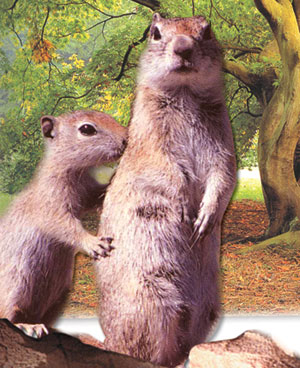 | 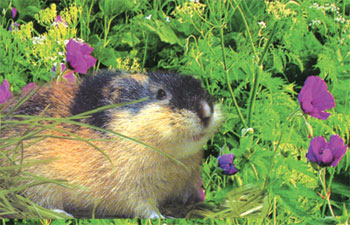 |
| Richardson's ground squirrels live in the western plains of North America. Their home usually takes the form of a maze-like burrow with one main entrance and several emergency exits. Young male squirrels travel 9.6 kilometers (6 miles) in 72 hours |
These herbivorous rodents that inhabit the tundra zones of the North Pole and the Alps live in large communities, and regularly migrate as a group.
Lemmings are seasonal migrators. In winter, they live in dry places or on rocky slopes with a thick covering of snow. When the snowmelt starts filling their underground burrows, they move to moist summer pastures next to rivers or bogs. At the end of the breeding season, they move back to the winter grounds. This migration begins in July and lasts several months. First the adult males leave the region, followed by the females and finally, the young lemmings. When the number of lemmings is low, their migration does not last long. But every three to four years the numbers greatly increase, and they can migrate over very great distances.55
Lemmings' bodies perfectly fit their environmental conditions and lifestyle. They remain active throughout the arctic winter without freezing to death, because their heavy fur that grows in the winter reduces heat loss and protects them from the cold. They also grow longer front claws. With their claws, they dig tunnels under the snow to form their burrows, where they live, protected from the cold and their predators.
God, Lord of the whole universe, has created lemmings in accord with their environmental conditions. For example, collared lemmings' coats turn from brown to white for the winter. In summer they are brown, but in winter they are all white. Their white winter coats help them to avoid the predators that depend upon them for food.
Footnotes
50- The life-cycles of an elephant can give key insights into their physical and intellectual processes;" http://elephant.elehost.com/About_Elephants/Life_Cycles/life_cycles.html51- John Owen, Fantastic Journey, p. 200
52- John Owen, Fantastic Journey, p.201
53- John Owen, Fantastic Journey, p.216
54- John Owen, Fantastic Journey, p.178
55- John Owen, Fantastic Journey, p.183
